ความหลากหลายทางพันธุกรรมของต้นประ (Elateriospermum tapos) ในอำเภอนบพิตำ จังหวัดนครศรีธรรมราช
คำสำคัญ:
ต้นประ, ความหลากหลายทางพันธุกรรม, นครศรีธรรมราชบทคัดย่อ
ต้นประ (Elateriospermum tapos) เป็นพรรณไม้ป่าและเป็นต้นไม้ที่พบมากในอำเภอนบพิตำ จังหวัดนครศรีธรรมราช ปัจจุบันต้นประมีจำนวนลดลงเนื่องจากการตัดไม้ทำลายป่า ดังนั้นจึงควรมีข้อมูลทางพันธุกรรมเพื่อใช้ในการวางแผนการจัดการ การวิจัยครั้งนี้มีวัตถุประสงค์ (1) เพื่อวิเคราะห์ความหลากหลายความหลากหลายทางพันธุกรรมของต้นประ (2) เพื่อวิเคราะห์โครงสร้างพันธุศาสตร์ประชากรของต้นประ และ (3) เพื่อวิเคราะห์ประวัติประชากรของต้นประในอำเภอนบพิตำ จังหวัดนครศรีธรรมราช โดยเก็บตัวอย่างใบประจากป่าธรรมชาติ ได้แก่ป่าธรรมชาติบ้านห้วยเลข ป่าธรรมชาติน้ำตกหินท่อ ป่าปลูกน้ำตกหินท่อ ป่าปลูกน้ำตกสุนันทา นำมาสกัดดีเอ็นเอและวิเคราะห์ลำดับนิวคลีโอไทด์จากยีน ribulose-bisphosphate carboxylase (rbcL) ในคลอโรพลาสต์ดีเอ็นเอและใช้ลำดับนิวคลีโอไทด์จากต้นประในประเทศมาเลเซียและบรูไนจาก National Center for Biotechnology Information (GenBank) เพื่อทำการวิเคราะห์ร่วมกัน รวมทั้งหมด 121 ลำดับนิวคลีโอไทด์ ผลการศึกษาพบแฮโพลไทป์ทั้งหมด 3 แฮโพลไทป์ โดยมีค่า haplotype diversity อยู่ในช่วง 0.000-0.667 และค่า nucleotide diversity อยู่ในช่วง 0.00000-0.00103 ผลการศึกษาโครงสร้างพันธุศาสตร์ประชากรพบการแบ่งกลุ่มประชากรออกเป็นสองกลุ่ม คือกลุ่มประชากรต้นประในอำเภอนบพิตำและกลุ่มประชากรต้นประจากประเทศมาเลเซียและบรูไน ผลการศึกษาประวัติประชากรพบว่าประชากรต้นประในอำเภอนบพิตำไม่มีการขยายขนาดประชากร
เอกสารอ้างอิง
Avise, J.C., Neigel, J.E., & Arnold, J. (1984). Demographic influences on mitochondrial DNA lineage
survivorship in animal populations. Journal of Molecular Evolution, 20, 99-105.
Ayala, F.J. (1982). Population and Evolutionary Genetics: A Primer. The Benjamin Cummings Pub.
Co. Inc, California.
Baimai, V., & Tanthalekha, R. (2007). Khaonan-Pamek: Natural and Global Warming. Bangkok:
Bangkok Ltd. (in Thai)
Deng, Y., Liu, T., Xie, Y., Wei, Y., Xie, Z., Shi, Y., & Deng, X. (2020). High genetic diversity and low
differentiation in Michelia shiluensis, an endangered magnolia species in South China. Forests, 11, 469; DOI: 10.3390/f11040469.
Excoffier, L., & Lischer, H.E.L. (2010). Arlequin suite ver 3.5: A new series of programs to perform
population genetics analyses under Linux and Windows. Molecular Ecology Resources, 10, 564-567.
Feng, X., Wang, Y., & Gong, X. (2014). Genetic diversity, genetic structure and demographic history
of Cycas simplicipinna (Cycadaceae) assessed by DNA sequences and SSR markers.
BMC Plant Biology, 14,187.
Fu, F.X. (1997). Statistical tests of neutrality of mutations against population growth, hitchhiking
and background selection. Genetics, 147, 915–925.
Gao, Y., Yin, S., Wu, L., Dai, D., Wang, H., Liu, C., & Tang, L. (2017). Genetic diversity and structure
of wild and cultivated Amorphophallus paeoniifolius populations in southwestern China
as revealed by RAD-seq. Scientific Reports 7, 14183.
Harpending, R.C. (1994). Signature of ancient population growth in a low-resolution mitochondrial
DNA mismatch distribution. Human Biology, 66, 591-600.
Huang, J.C., Wang, W.K., Peng, C.I., & Chiang T. Y. (2005). Phylogeography and conservation genetics
of Hygrophila pogonocalyx (Acanthaceae) based on atpB-rbcL noncoding spacer cpDNA. Journal of plant research, 118, 1-11.
Jaroensutasinee, M. (2008). The impact of climatic factors on the appearance of parah tree
Retrieved from http://www.thaienergynews.com (in Thai), [2019, 20 September.]
Larkin, M.A., Blackshields, G., Brown, N.P., Chenna, R., McGettigan, P.A., McWilliam, H., Valentin,
F., Wallace, I.M., Wilm, A., Lopez, R., Thompson, J.D., Gibson, T.J., & Higgins, D.G. (2007).
Sequence analysis Clustal W and Clustal X version 2.0. Bioinformatics Applications Note,(21), 2947-2948.
Librado, P., & Rozas, J. (2009). DnaSP v5: a software for comprehensive analysis of DNA polymorphism
data. Bioinformatics, 25, 1451-1452.
Nei, M. (1987). Molecular Evolutionary Genetics. New York: Columbia University Press. Ramirez-Soriano A., Ramos-Onsins, S.E., Rozas, J.F., & Navarro, A. (2008). Statistical power analysis of neutrality tests under demographic expansions, contractions and bottlenecks with recombination. Genetics, 179, 555-567.
Rogers, A.R., & Harpending, H. (1992). Population growth makes waves in the distribution of pairwise
genetic differences. Molecular Biology and Evolution, 9, 552-569.
Slatkin, M. (1987). Rare alleles as indicators of gene flow. Evolution, 39(1), 53-65.
Su, Y.J., Wang, T., Zheng, B., Jiang, Y., Ouyang, P.Y., & Chen, G.P. (2005). Genetic variation and phylogeographical patterns in Alsophila podophylla from Southern China based on cpDNA
atpB-rbcL sequence data. American Fern Journal, 95(2), 68-79.
Sun, Y., Yang, H., Zhang, Q., Qin, L., Li, P., Lee, J., Chen, S., Rahman, K., Kang, T., & Jia, M. (2019).
Genetic diversity and its conservation implications of Vitex rotundifolia (Lamiaceae) populations in East Asia. Retrieved from http://doi.org/10.7717/peerj.6194
Tajima, F. (1989). Statistical method for testing the neutral mutation hypothesis by DNA polymorphism.
Genetics, 123, 585–595.
Tamura, K., Dudley, J., Nei, M., & Kumar, S. (2007). MEGA 4: molecular evolutionary genetics analysis
(MEGA) software version 4.0. Molecular Biology and Evolution, 24, 1596–1599.
Tokuoka, T. (2007). Molecular phylogenetic analysis of (Euphorbiaceae sensu stricto) based on plastid
and nuclear DNA sequences and ovule and seed character evolution. Journal of plant
research, 120(4), 511-522.
Wurdack, K.J., Hoffmann, P., & Chase, M.W. (2005). Molecular phylogenetic analysis of uniovulate
Euphorbiaceae (Euphorbiaceae sensu stricto) using plastid RBCL and TRNL-F DNA sequences.
American journal of botany, 92(8), 1397-1420.
Yang, Z. (2006). Computational molecular evolution. Oxford University Press, New York.
Zhao, Y.J., & Gong, X. (2012). Genetic structure of the endangered Leucomeris decora (Asteraceae)
in China inferred from chloroplast and nuclear DNA markers. Conservation genetics, 13, 271-281
ดาวน์โหลด
เผยแพร่แล้ว
ฉบับ
ประเภทบทความ
สัญญาอนุญาต
โปรดกรอกเอกสารและลงนาม "หนังสือรับรองให้ตีพิมพ์บทความในวารสารวิจัยมหาวิทยาลัยราชภัฏพระนคร สาขาวิทยาศาสตร์และเทคโนโลยี" ก่อนการตีพิมพ์




